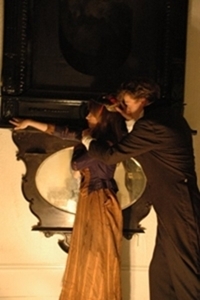As was the case with Hammergrin Theatre’s 2008 production for the Cork Midsummer Festival, one suspects there is a coherent narrative underlying this year’s tale of the strange and wondrous Hollander House on Cork’s North Mall. However, this is a play with so many interludes, diversions and meanderings from the central storyline that, to be frank, it is not always easy to keep up.
While those of us who have been here before - at K: The Iowa Project last year, or at one or other of Hammergrin’s projects - will know what to expect, and know also that any confusion we feel will, likely, not be enough to take from our overall enjoyment of what once again turns out to be a fresh, innovative and irreverent piece of work, the challenge for the first-timers among us is to remain open to the Hammergrin experience, which typically involves an amount of surreal activity, a degree of audience participation, and, most importantly, the incorporation of the environment as an actor in its own right.
I n this case this involves, firstly, a long, rather drawn out, opening sequence during which the small audience (numbers are limited to 14) is blindfolded, and ushered into – we are reliably informed – a chapel bathed in blinding light. There we are seated, presented with pencil and paper, and instructed to draw the face of our loved one. The drawings are then hastily snatched from us, never to feature again in the play. This thoroughly amusing, but largely inconsequential beginning, echoes, to some extent, the starting point of the Iowa Project last year, which also seemed to tell us very little, instead drawing us into a kind of Alice-in-Wonderland world where we can expect anything to happen.
n this case this involves, firstly, a long, rather drawn out, opening sequence during which the small audience (numbers are limited to 14) is blindfolded, and ushered into – we are reliably informed – a chapel bathed in blinding light. There we are seated, presented with pencil and paper, and instructed to draw the face of our loved one. The drawings are then hastily snatched from us, never to feature again in the play. This thoroughly amusing, but largely inconsequential beginning, echoes, to some extent, the starting point of the Iowa Project last year, which also seemed to tell us very little, instead drawing us into a kind of Alice-in-Wonderland world where we can expect anything to happen.
What happens is Hollander House itself, first introduced to us through a kind of drawing room, where teacups emerge from holes in the wall, a chambermaid (Una Kirwan) clambers out of a fireplace and the whole place shakes vigorously from time to time. As the eccentric master of the house, Hollander (John McCarthy), nervously explains, while handing out cups of tea, given these strange happenings it is important we keep on our guard at all times.
Hammergrin – a young company only four years old – has learned how to create theatre that is both experience and sensation.
Hollander does have a story – something to do with a wife who may or may not be hidden deep in the cellar, a man who never grows old, a 1622 battle of the starlings, and a house that has been lifted to sea and back by hot air balloon – and he guides us from room to room in order to tell it. But this takes an immeasurably subservient place to the house itself, which is at the heart of this piece of theatre, and whose wondrous rooms (designed and constructed by Ronan Fitzgibbon and Bobby O’Neill respectively) almost negate the need for a lucid account for us to follow.
For example, after the introductions, Hollander leads us through to a living area, which has been turned upside down – the result of the balloon ride. As he recites his narrative, it takes a while, in the low lit room, to become aware of the fact that we are standing on what was the ceiling, with lights, pictures and even a fireplace the wrong way up and out of place. In the corner sit three classical musicians, along with a prostitute (Irene Kelleher), who has been hired, it appears, to dance with Hollander in the stead of his lost wife. The story continues, but the pleasure here is all in the sensations: the strange beauty of the surroundings, the eerie, evocative music, the way Hollander hammers nails into the wall, desperately seeking to track the movements of his wife.
The next room, entirely covered with tracing paper - the result of Hollander’s efforts to map both the changes in the city and his wife’s progress - has the same impact: it is an effort to keep up with what the narrator is saying, so much is there to take in. And so it goes, until the moment when Hollander, finally determined to take control of his life, tentatively walks down the alleyway to the side of his house and timidly steps out into the world. Once again, it is the image - of the man in the top hat walking away from his audience - which is most resonant, and leaves the lasting impression.
All this proves that Hammergrin – a young company only four years old – has learned how to create theatre that is both experience and sensation. What the company has not yet mastered, however, is how to integrate a tightly focused, emotionally engaging narrative into its work. Should the writers (John McCarthy, Ciaran O Conaill and Sara-Jane Power, who also directs) learn how to do this, and should they also create more rounded, three-dimensional characters who will better draw the audience into their worlds, then Hammergrin has the potential to become one of the most exciting companies working in Irish theatre today.
Rachel Andrews is an arts journalist and critic based in Cork.